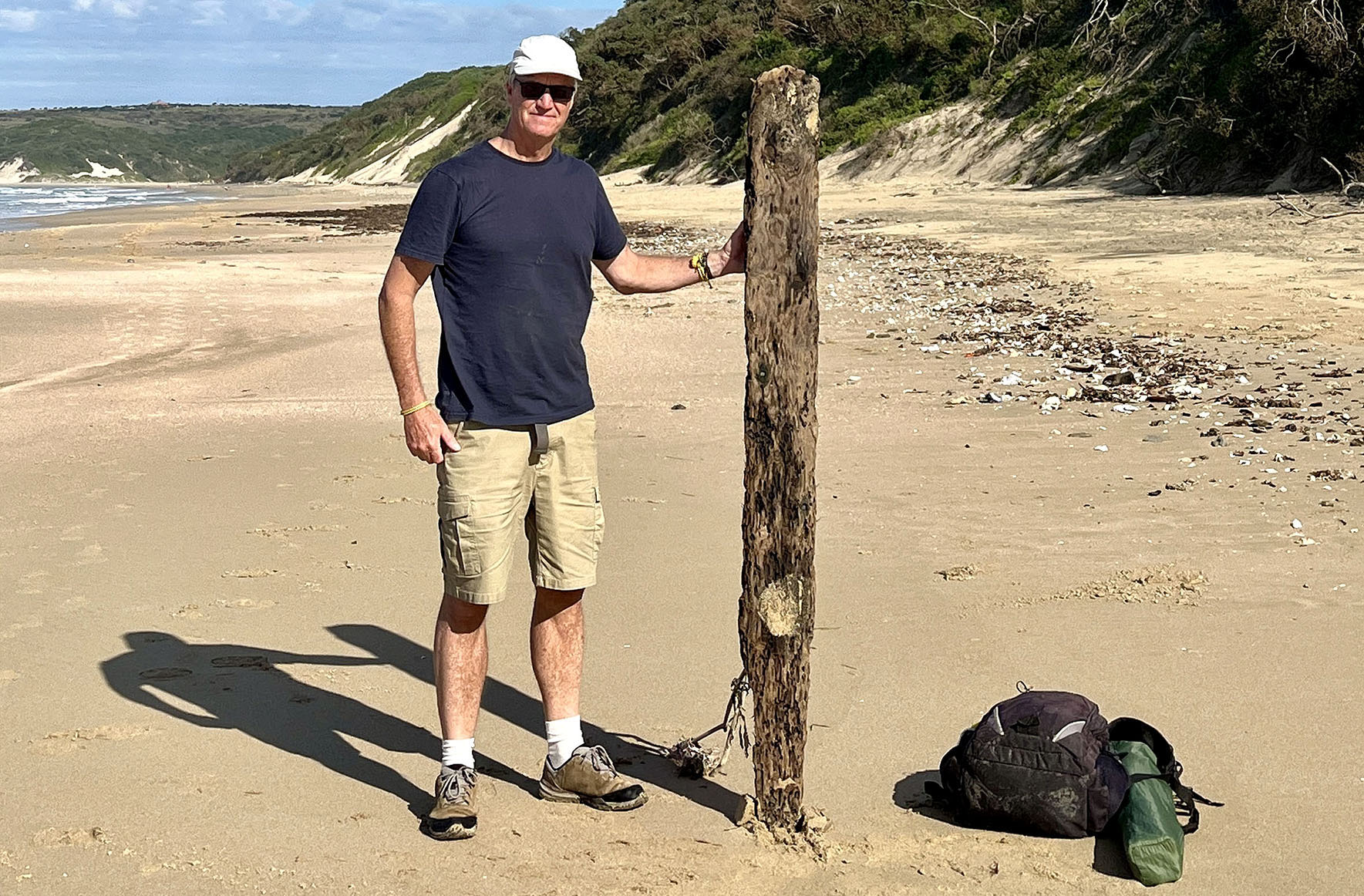A coastal storm helped East London Museum scientist Kevin Cole uncover what he believes is a piece of a ship that sank 150 years ago off Chintsa Beach in East London.
Cole has been involved in a study into increased coastal erosion along the South African coast. Shipwreck timber has been found in eroding dunes and Cole said storm surges were bringing new treasures to land from the sandy bottom of Chintsa Bay.
 Yellow circles drawn on the piece of wood found in the Eastern Cape believed to be from a Portuguese shipwreck, show where experts found wooden trunnels (pegs) used to fasten timber. (Photo: Supplied)
Yellow circles drawn on the piece of wood found in the Eastern Cape believed to be from a Portuguese shipwreck, show where experts found wooden trunnels (pegs) used to fasten timber. (Photo: Supplied)
 Yellow circles show where bronze spikes are found in the wood, believed to be from a Portuguese shipwreck. (Photo: Supplied)
Yellow circles show where bronze spikes are found in the wood, believed to be from a Portuguese shipwreck. (Photo: Supplied)
“But I am on holiday,” he said, telling of his find, a large piece of timber. “So this is just an old codger who found an important piece of timber.”
Jokes aside, Cole believes the timber could be part of the hull of the ill-fated Italian vessel the Nuovo Abele.
Read more in Daily Maverick: Kleinzee Shipwreck Trail — South Africa’s Diamond Coast, where vessels fear to land
Cole said there were records of two shipwrecks at Chintsa Mouth. In 1647, the Nossa Senhora de Atalaia, a Portuguese trade ship on her way to Lisbon, sank off the coast near Chintsa.
The Atalaia had anchored in Chintsa Bay for repairs, but took on so much water that she sank. About 200 passengers and crew members survived the wreck. The wreck’s guns and bronze cannon were salvaged in 1980 and are on display in the East London Museum.
The other was the Italian wooden barque Nuovo Abele that sank at the mouth of the Chintsa River in 1874 while en route to London with a cargo of sugar. The 13 crew members were rescued when Frontier Armed Mounted Police swam a line out to the wreck. Pieces of the Nuovo Abele were uncovered after storm surges in 2015 and 2020.
 A stone-aged tool East London museum scientist Kevin Cole found on the beach at Chintsa is believed to be between 280,000 and 25,000 years old. (Photo: Supplied)
A stone-aged tool East London museum scientist Kevin Cole found on the beach at Chintsa is believed to be between 280,000 and 25,000 years old. (Photo: Supplied)
In his 2015 report to the South African Heritage Association, Cole wrote that a previous piece of the ship that had been found after storm surges, measured 3.23m from tip to tip, with the widest portion measuring 67cm.
“An assumption is that the material could be from the 1874 ship the Nuovo Abele (Nova Bella) grounded in Chintsa Bay. If it is the Nuovo Abele, this ship was built in 1873 and weighed 690 tons. It was captained by Cuneo Francisco and was wrecked during a southwest gale on the 6th December 1874. It was on a voyage from Batavia (Jakarta) to London with a cargo of sugar. The condition of the artefact is the same as it was found and is under the curatorial regime of the museum conservator as directed,” Cole said in his report.
In 2020, Cole wrote an article for the East London Museum when more pieces of the Nuovo Abele were found.
The new find also has the “tell-tale signs” of wooden and square bronze spikes, he said.
He said the ship had been broken up by the sea in the more than a century that it had been underwater.
Read more in Daily Maverick: The Antipolis wreck: Ship’s memories resurface from the deep during exceptional summer storm
“I have secured the timber safely,” he said about his most recent find.
The procedure now is to mark the GPS coordinates where the timber was found and apply for it to be removed for study and conservation.
“It needs to go for conservation. This takes a long time. I am excited about this find because of its size. It is about my height. Of course, our first question would be: Where does it come from now?” DM




 A stone-aged tool East London museum scientist Kevin Cole found on the beach at Chintsa is believed to be between 280,000 and 25,000 years old. (Photo: Supplied)
A stone-aged tool East London museum scientist Kevin Cole found on the beach at Chintsa is believed to be between 280,000 and 25,000 years old. (Photo: Supplied) 